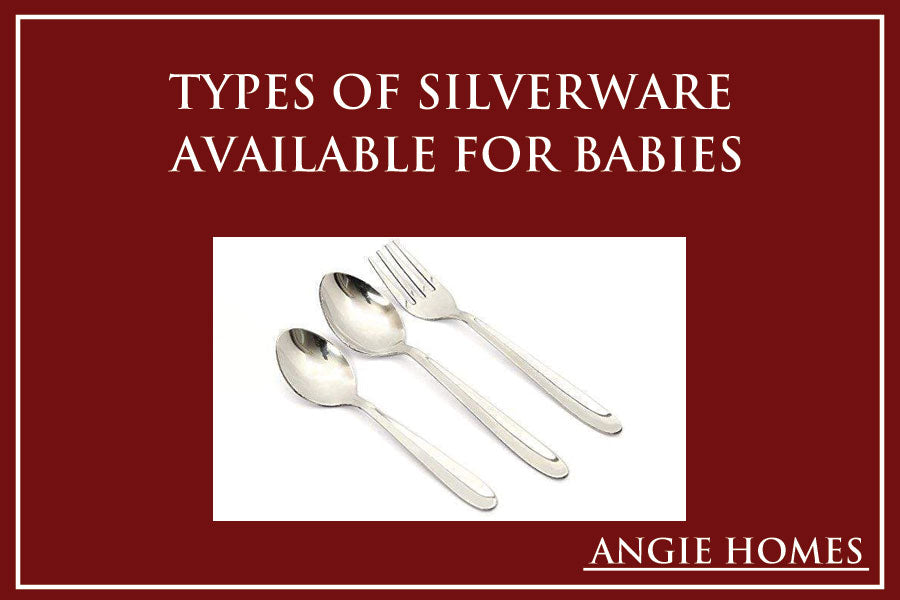Introducing silverware to babies is a pivotal step in their developmental adventure, fostering critical skills and selling independence. As toddlers transition to stable foods, incorporating appropriate utensils not only aids in refining motor capabilities but also encourages self-feeding, contributing to the overall increase of exceptional motor abilities. The advantages extend beyond practicality. Using Silverware for Babies introduces toddlers to special textures and temperatures, enhancing their sensory reports. Parents can pick from a variety of child-friendly utensils designed with safety and luxury in mind. Soft-tip spoons, ergonomic handles, and temperature-sensitive substances are many of the alternatives available, ensuring a seamless transition to independent consumption. As caregivers guide toddlers through this milestone, the careful selection of appropriate silverware proves instrumental in shaping high-quality consuming behaviour and setting up a basis for lifelong talents.
Why Use Silverware for Babies?

Firstly, silverware performs a crucial function in refining an infant's excellent motor competencies. The act of gripping and manipulating utensils enables the beautification of their hand-eye coordination and dexterity, setting the stage for greater advanced motor features later in existence. As infants embark on the adventure of transitioning to stable meals, the advent of silverware encourages self-feeding, fostering a feeling of independence and autonomy.
Moreover, the choice of silver as a material for child utensils goes past mere way of life. Silver possesses inherent antimicrobial residences that inhibit the increase of microorganisms, making sure a cleaner and more secure ingesting environment is available for babies. This fine is, in particular, important given the susceptibility of infants to infections and the significance of maintaining a hygienic feeding environment.
Additionally, exposing infants to one-of-a-kind textures and temperatures through the Using Silverware for Babies complements their sensory stories. The varied sensations encountered in the course of meals contribute to the improvement in their sensory processing abilities, refining their know-how of taste and touch.
In essence, the use of silverware for infants is a holistic technique for nurturing their bodily and cognitive improvement. It no longer only facilitates the realistic components of feeding but also cultivates skills and conduct that lay the foundation for a lifetime of wholesome and impartial ingesting.
Types of Silverware Available for Babies

When it comes to choosing silverware for babies, caregivers have a plethora of alternatives designed to cater to the specific needs and developmental levels of toddlers. These utensils prioritize protection, comfort, and capability to ease the transition to self-feeding. Here are some fantastic kinds of silverware available for babies:
-
Soft-Tip Spoons
Soft-tip spoons are a popular desire for introducing toddlers to strong ingredients. These spoons are crafted with a gentle, rubberized tip that is gentle at the infant's gums and emerging enamel. The smooth material minimizes the hazard of unintended injuries whilst presenting a cushy reveal for the infant during mealtime.
-
Ergonomic Handles
Utensils with ergonomic handles are designed to fit conveniently in a toddler's small hands. The form and size of those handles are crafted to promote a natural grip, allowing toddlers to comprehend the utensils without problems. This layout encourages the improvement of great motor abilities as toddlers learn to coordinate their hand movements throughout self-feeding.
-
Temperature-sensitive utensils
Temperature-touchy Using Silverware for Babies is a realistic desire for mothers and fathers concerned with serving food at a top-quality temperature. These utensils trade colouration or have indicators to alert caregivers when food is too warm for the child to consume. This feature guarantees that the child's delicate palate is blanketed from potential burns, selling a more secure and greater enjoyable mealtime revel in.
-
Divided Plates and Bowls
While traditional silverware is no longer used, divided plates and bowls are crucial components of a baby's eating set. These objects regularly come with suction bases to prevent unintentional spills. Divided sections help portion distinct types of food, sell a balanced food plan, and facilitate the creation of diverse textures and flavours.
-
Training Forks
As babies develop their self-feeding adventure, schooling forks become valuable equipment for boosting dexterity. These forks usually have rounded and blunted prongs to lessen the threat of harm. Training forks are designed to assist infants in transitioning from the use of spoons to extra superior utensils as they develop the coordination needed to pierce and raise food.
-
Self-Feeding Utensils
Self-feeding utensils are specifically crafted to empower infants as they have the advantage of independence in ingesting. These utensils regularly feature shorter handles and broader, shallow bowls, permitting babies to scoop and grasp meals extra without difficulty. Self-feeding utensils inspire the improvement of hand-eye coordination and the pincer hold close, critical skills for transitioning to personal utensils.
-
Travel-Friendly Sets
For on-the-pass parents, journey-friendly silverware units are designed to be compact and, without difficulty, transportable. These sets often come with a sporting case to preserve utensils easily and prepare them. The comfort of journey sets permits caregivers to keep a consistent feeding recurring, whether or not home or away.
-
Silver-Plated Keepsake Utensils
Some families choose to use silverware for Babies' souvenir utensils, frequently engraved with the toddler's call or birthdate. While these may not be used for normal feeding, they hold a sentimental price and may be loved as family heirlooms or gifts for unique events.
Tips to Use Silverware for Babies

Certainly! Here are 5 comprehensive pointers on the way to introduce and use silverware for babies:
Tip 1: Start Slow and Gradual Introduction
Introducing silverware to your baby is a slow method that requires staying power. Begin by permitting your infant to explore the utensils all through mealtime without the expectancy of their usage for ingesting. This enables them to turn out to be familiar with the brand-new objects and creates a nice affiliation. Hold the utensils out on your baby, permitting them to contact and sense the different textures. This sensory exploration aids in building their comfort and interest.
As your toddler becomes aware of the presence of the silverware, step by step, include them into the feeding habit. Initially, allow them to maintain the utensils whilst you manual their hand in gentle motions. As they develop greater comfort, encourage them to make their very own attempts at self-feeding. Remember, the aim is not on-the-spot perfection but, as an alternative, a steady progression towards independent use.
Tip 2: Choose Baby-Friendly Utensils
Selecting appropriate Silverware for Babies is essential for wonderful and secure enjoyment. Opt for smooth-tip spoons with gentle, rubberized ends to shield your infant's touchy gums and rising enamel. The soft cloth minimizes the hazard of accidental accidents and ensures a comfortable revel in the course of mealtime. Ergonomic handles designed for small fingers promote a natural grip, facilitating the improvement of satisfactory motor abilities.
Consider the use of utensils with temperature-sensitive capabilities, which could indicate if the food is too warm for the toddler. This prevents capacity burns and guarantees a more secure dining experience. The right utensils now not only make contributions to your infant's comfort but also aid their developmental milestones.
Tip 3: Encourage Self-Feeding for Independence
Foster independence through encouraging self-feeding from an early age. Place chew-sized, age-suitable finger foods on your toddler's tray together with the silverware. While it can, first of all, result in messiness, permitting your child to explore and practice self-feeding is vital for his or her improvement. Offer guidance as wanted; however, give them the opportunity to understand, scoop, and test with the utensils.
Self-feeding no longer only enhances nice motor competencies but also builds self-assurance and a wonderful association with mealtimes. Be organized for a slow transition, with some food concerning greater self-feeding tries than others. Celebrate your infant's efforts and progress, reinforcing the idea that mealtime is an enjoyable and empowering experience.
Tip 4: Create a Positive Mealtime Environment
The atmosphere throughout mealtime plays a huge function in the fulfilment of introducing silverware to your infant. Create effective and engaging surroundings by making mealtime interactive. Use colourful utensils, inform testimonies, or sing songs to capture your infant's interest. Turn mealtime right into a laugh and fun revel in, associating silverware use with advantageous interactions.
Maintain a comfortable environment, warding off pressure or strain across the advent of utensils. Be affected person and information, recognizing that spills and messes are a natural part of the studying method. Your superb mindset and encouragement contribute to a healthy mindset toward mealtime and self-feeding.
Tip 5: Be Patient, Observe, and Adjust
Patience is prime when introducing silverware to your toddler. Each infant develops at their very own tempo, and the gaining knowledge of manner may additionally range. Be observant of your infant's cues and adjust your approach for that reason. If your toddler seems snug with arms-on exploration, first of all, permit them that freedom earlier than step-by-step integrating utensils.
Monitor their progress and celebrate even small achievements. Notice enhancements in coordination, grip strength, and self-feeding attempts. Adjust the kind of utensils based on their developmental degree, transitioning from gentle-tip spoons to more advanced utensils like forks as they become geared up.
Remember that the goal isn't perfection but gradual improvement. If your infant indicates resistance or frustration, remember to take a step back and reintroduce utensils in a more playful and comfortable manner. Consistency is critical. However, flexibility in your approach guarantees a positive and successful experience for each of you and your child.
How to Clean Silver Vessels?

Cleaning silver vessels is vital to keep their lustrous shine. Whether using traditional methods like baking soda and aluminium foil or choosing industrial cleaners, proper care ensures toughness. Explore diverse strategies, from herbal alternatives like:
-
Traditional Silver Cleaning with Baking Soda and Aluminum Foil
A popular and effective approach to cleaning silver vessels includes an easy chemical response using baking soda and aluminium foil. Start by placing a sheet of aluminium foil at the bottom of a basin or sink. Lay the silver vessels on top of the foil. Create a mixture of boiling water and baking soda and pour it over the silver gadgets. Let the chemical response occur, causing the tarnish to transfer from the silver to the aluminium foil. Rinse the silver items very well with water and dry them with a soft material.
-
Lemon and Salt Paste
Create a herbal cleaning paste using lemon and salt. Mix lemon juice and salt to form a thick paste. Apply the paste to the tarnished regions of the silver vessels, making sure it is a fair coating. Allow it to sit down for 10-15 minutes to let the natural acidity of the lemon paint the tarnish. Use a tender cloth or a sponge to softly scrub the silver, focusing on the tarnished spots. Rinse the vessels with water and dry them with a clean, soft fabric.
-
Commercial Silver Cleaners
Commercial silver cleaners are easily available and provide a handy solution. Follow the commands on the product label for the fine consequences. Typically, these cleaners involve applying the solution to the silver, allowing it to sit for a certain time, and then rinsing and drying the vessels. Ensure proper ventilation when the use of industrial cleaners and wear protective gloves as recommended through the product commands.
-
Toothpaste for Gentle Cleaning
For a gentler approach, toothpaste may be used to easy silver vessels. Apply a small amount of non-gel, non-abrasive toothpaste to a tender cloth or sponge. Gently rub the tarnished areas using circular motions. Rinse the vessels thoroughly with water and dry them with a smooth, smooth material. This method is appropriate for mild tarnish and affords a moderate cleaning choice.
Conclusion
In conclusion, introducing silverware to babies proves to be a pivotal developmental step with multifaceted blessings. The cautious selection of utensils now not only refines motor abilities but also instils a feeling of independence and high-quality consuming conduct. The ergonomic layout of infant-pleasant silverware, such as tender-tip spoons, ensures safety and comfort in the course of the transition to self-feeding. The antimicrobial properties of silver contribute to a hygienic dining environment, emphasizing realistic issues further to developmental advantages. Overall, the considerate incorporation of silverware right into an infant's feeding lays the inspiration for a wholesome and unbiased approach to mealtime, reaping benefits for their typical increase and proper well-being.
Related Posts:
A Comprehensive Guide to Kids Silverware, Benefits, and Top Picks in India
An Ultimate Guide on Silverware, Its Types, Benefits, and Timeless Charm
Benefits Of Using Silver Bowls And Spoons To Feed A Baby
Silver Utensils are Best for Babies: Myths vs Facts
Do You Know the Benefits of Using Silver Utensils for Kids?
Top 30 Silverware for Babies and Kids
Using Silverware For Babies -Importance, Benefits, And Precautions
FAQ's
Q. What are the benefits of silverware?
Ans: Silverware for infants offers developmental blessings through refining motor abilities, promoting independence, and enhancing sensory reports through publicity of exceptional textures and temperatures.
Q. Which utensil is right for toddlers?
Ans: Soft-tip spoons with ergonomic handles are recommended for babies, imparting protection and luxury all through the transition to impartial ingesting.
Q. Why is silver used for toddlers?
Ans: Silver is chosen for toddler utensils because of its antimicrobial properties, ensuring a hygienic dining experience and minimizing the threat of bacterial contamination.
Q. Is silver excellent success for infants?
Ans: While silver is frequently related to proper good fortune, its use for infants is based totally on practical issues like hygiene and safety as opposed to superstition.
